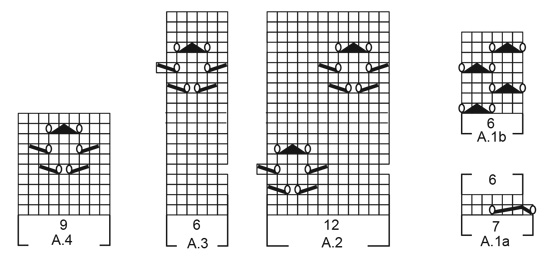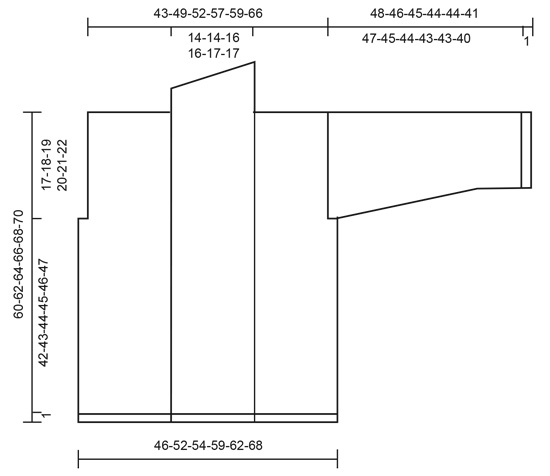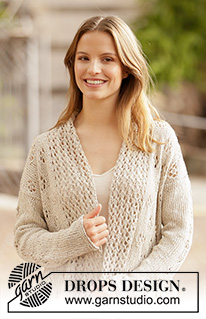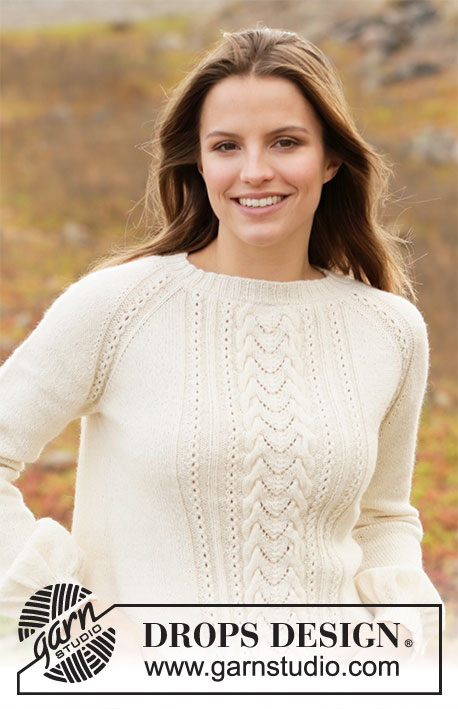Free Flow |
|||||||||||||||||||
 |
 |
||||||||||||||||||
Knitted long jacket with shawl collar in DROPS Bomull-Lin or DROPS Paris. Piece is knitted with lace pattern. Size XS–XXL.
DROPS 213-18 |
|||||||||||||||||||
|
---------------------------------------------------------- EXPLANATION FOR THE PATTERN: ---------------------------------------------------------- GARTER STITCH (worked in the round): 1 ridge vertically = 2 rounds, i.e. knit 1 round and purl 1 round. GARTER STITCH (back and forth): Knit all rows. 1 ridge vertically = knit 2 rows. PATTERN: See diagram A.1 to A.4 (diagram A.4 applies to sleeves). Diagrams show all rows in pattern seen from the right side. INCREASE TIP (applies to sleeves): Work until 2 stitches remain before marker thread, 1 yarn over, knit 4 (marker thread is in the middle of these stitches), 1 yarn over. On next round knit yarn overs twisted to avoid holes. Then work the new stitches in stockinette stitch. ---------------------------------------------------------- START THE PIECE HERE: ---------------------------------------------------------- JACKET - SHORT OVERVIEW OF THE PIECE: Work body back and forth on circular needle up to armhole. Then bind off stitches for armholes in each side, and work front pieces and back piece back and forth separately. Work sleeves in the round on double pointed needles/a short circular needle. BODY: Cast on 169-189-195-225-231-251 stitches (including 1 edge stitch in each side towards mid front) on circular needle size 5 mm = US 8 with Bomull-Lin or Paris. Work 2 ridges in GARTER STITCH - read explanation above. Switch to circular needle size 5.5 mm = US 9. Work next row in the different sizes as follows: Size XS, L, XL: Work 1 edge stitch in garter stitch, A.1a over the next 21-28-28 stitches (= 3-4-4 repetitions of 7 stitches), knit 4-3-2, A.2 over the next 12-24-24 stitches (= 1-2-2 repetitions of 12 stitches), A.3 over the next 6-6-6 stitches (= 1 repetition of 6 stitches), knit 4-3-5, insert a marker thread here (= in the side), knit 3-2-4, A.2 over the next 60-84-84 stitches (= 5-7-7 repetitions), A.3 over the next 6-6-6 stitches (= 1 repetition), knit 4-3-5, insert a marker thread here (= in the side), knit 3-2-4, A.2 over the next 12-24-24 stitches (= 1-2-2 repetitions), A.3 over the next 6-6-6 stitches (= 1 repetition of 6 stitches), knit 5-4-3, A.1a over the next 21-28-28 stitches (= 3-4-4 repetitions), 1 edge stitch in garter stitch. Size S, M, XXL: Work 1 edge stitch in garter stitch, A.1a over the next 21-21-28 stitches (= 3-3-4 repetitions of 7 stitches), knit 4-3-2, A.2 over the next 24-24-36 stitches (= 2-2-3 repetitions of 12 stitches), knit 3-5-4, insert a marker thread here (= the side), knit 2-4-3, A.2 over the next 72-72-96 stitches (= 6-6-8 repetitions), A.3 over the next 6-6-6 stitches (= 1 repetition of 6 stitches), knit 3-5-4, insert a marker thread here (= in the side), knit 2-4-3, A.2 over the next 24-24-36 stitches (= 2-2-3 repetitions), knit 5-4-3, A.1a over the next 21-21-28 stitches (= 3-3-4 repetitions), 1 edge stitch in garter stitch. All sizes: When first row has been worked, 1 stitch has been decreased in every repetition A.1a on row (= 6-6-6-8-8-8 stitches decreased in total) = 163-183-189-217-223-243 stitches. Work 1 row from wrong side. Now work A.1b over every repetition A.1a and work pattern as before over the remaining stitches on row. NOTE! On 5th row in A.2 work 1 more knit stitch before the first stitch in diagram (applies first time diagram is worked after band stitches on right front piece and after marker thread in the sides). On 15th row in A.3 work 1 knit stitch less after the last stitch in diagram (applies before marker thread in the sides and before band stitches on left front piece. REMEMBER THE KNITTING GAUGE! When piece measures 43-44-45-46-47-48 cm = 17"-17¼"-17¾"-18"-18½"-19" - adjust so that next row is worked from wrong side, bind off 2 stitch in each side, i.e. 1 stitch on each side of marker thread in each side. Then finish front pieces and back piece separately. BACK PIECE: = 71-81-85-93-97-107 stitches. Work first row as follows from right side: 1 edge stitch in garter stitch, knit 2-1-3-1-3-2, work pattern as before over the next 66-78-78-90-90-102 stitches, knit 1-0-2-0-2-1, 1 edge stitch in garter stitch. Continue back and forth like this. When piece measures 55-57-59-61-63-65 cm = 21⅝"-22½"-23¼"-24"-24¾"-25½", do not begin any more lace patterns vertically (this way the neck isn’t bind off in the middle of working a lace pattern).When last lace pattern has been worked, continue with stockinette stitch and 1 edge stitch in garter stitch in each side. When piece measures 58-60-62-64-66-68 cm = 22¾"-23⅝"-24⅜"-25¼"-26"-26¾", bind off the middle 21-21-23-23-25-25 stitches for neck, and finish each shoulder separately. On next row from the neck, bind off 1 stitch = 24-29-30-34-35-41 stitches. When piece measures 60-62-64-66-68-70 cm = 23⅝"-24⅜"-25¼"-26"-26¾"-27½", bind off all stitches. Work the other shoulder the same way. RIGHT FRONT PIECE: = 44-49-50-60-61-66 stitches. Work first row from right side as follows: 1 edge stitch in garter stitch, work A.1b over the next 18-18-18-24-24-24 stitches, knit 4-4-3-3-2-2, work pattern as before over the next 18-24-24-30-30-36 stitches, knit 2-1-3-1-3-2, 1 edge stitch in garter stitch. Continue back and forth like this. When piece measures 60-62-64-66-68-70 cm = 23⅝"-24⅜"-25¼"-26"-26¾"-27½" – adjust so that next row is worked from wrong side, bind off the first 24-29-30-34-35-40 stitches for shoulder, then work over the last 20-20-20-26-26-26 stitches as before. Continue with lace pattern and 1 edge stitch in garter stitch in each side until band measures 7-7-7-7-8-8 cm = 2¾"-2¾"-2¾"-2¾"-3⅛"-3⅛" from shoulder. At the beginning of the next 3-3-3-4-4-4 rows from wrong side, bind off the first 5 stitches = 5-5-5-6-6-6 stitches remain. Loosely bind off the last stitches on next row from wrong side LEFT FRONT PIECE: = 44-49-50-60-61-66 stitches. Work first row from right side as follows: 1 edge stitch in garter stitch, knit 1-0-2-0-2-1, pattern as before over the next 18-24-24-30-30-36 stitches, knit 5-5-4-4-3-3, A.1b over the next 18-18-18-24-24-24 stitches, 1 edge stitch in garter stitch. Continue back and forth like this. When piece measures 60-62-64-66-68-70 cm = 23⅝"-24⅜"-25¼"-26"-26¾"-27½" – adjust so that next row is worked from right side, bind off the first 24-29-30-34-35-40 stitches for shoulder, then work over the last 20-20-20-26-26-26 stitches as before. Continue with lace pattern and 1 edge stitch in garter stitch in each side until band measures 7-7-7-7-8-8 cm = 2¾"-2¾"-2¾"-2¾"-3⅛"-3⅛" from shoulder. At the beginning of the next 3-3-3-4-4-4 rows from right side, bind off the first 5 stitches = 5-5-5-6-6-6 stitches remain. Loosely bind off the last stitches on next row from right side SLEEVES: Cast on 35-35-37-39-41-41 stitches on double pointed needles size 5 mm = US 8 with Bomull-Lin or Paris. Work 2 ridges. Switch to double pointed needles size 5.5 mm = US 9. Insert a marker thread at beginning of round (= mid under sleeve). Work pattern as follows: Knit 13-13-14-15-16-16, A.4 (= 9 stitches) knit 13-13-14-15-16-16. Work pattern in the round as follows. When piece measures 8-8-8-9-9-9 cm = 3⅛"-3⅛"-3⅛"-3½"-3½"-3½", increase 2 stitches under sleeve - read INCREASE TIP! Increase like this approx. every 4-3½-3-2½-2½-2 cm = 1½"-1¼"-1⅛"-⅞"-⅞"-¾" 10-11-12-13-13-15 times in total = 55-57-61-65-67-71 stitches. When sleeve measures 43-41-40-39-39-36 cm = 17"-16⅛"-15¾"-15¼"-15¼"-14¼", do not begin any more lace patterns vertically (this way the sleeve isn’t bind off in the middle of working a lace pattern). Continue in the round in stockinette stitch. When sleeve measures 48-46-45-44-44-41 cm = 19"-18"-17¾"-17¼"-17¼"-16⅛", bind off all stitches. Work the other sleeve the same way. ASSEMBLY: Sew shoulder seams with grafting/kitchener stitches inside bind-off edge. Sew sleeves in body inside 1 edge stitch in garter stitch on body and inside bind-off edge on sleeve. Sew the collar together mid back and sew it to the neck. Fasten off. Bomull-Lin will be more even and look better after it has been washed. When the garment is finished, soak it, stretch it to correct measurements - see chart, and leave it to dry flat. |
|||||||||||||||||||
Diagram explanations |
|||||||||||||||||||
|
|||||||||||||||||||

|
|||||||||||||||||||

|
|||||||||||||||||||
|
Have you made this or any other of our designs? Tag your pictures in social media with #dropsdesign so we can see them! Do you need help with this pattern?You'll find tutorial videos, a Comments/Questions area and more by visiting the pattern on garnstudio.com. © 1982-2024 DROPS Design A/S. We reserve all rights. This document, including all its sub-sections, has copyrights. Read more about what you can do with our patterns at the bottom of each pattern on our site. |
|||||||||||||||||||

































































Comments / Questions (64)
For the S,M XXL sizes there is only one A.3 pattern to work per row. Is this correct? I noticed A.3 is worked twice in each row for the XS,L, XL sizes which looks to me right as it keeps the symmetry. Looking forward for your answer .
09.05.2020 - 19:27DROPS Design answered:
Dear Maria, you don't work the same diagrams in all sizes because of there are less stitches worked in A.2 in sizes XS, L and XL you finish the pattern with A.3 and in the other size you work A.2 over more stitches. Happy knitting!
11.05.2020 - 11:06Hello, is A.1a only worked in the first row? And for the rest of the rows is always A.1b? Thank you
09.05.2020 - 15:25DROPS Design answered:
Dear Maria, A.1a is only 2 rows (1 row with decrease + 1 row from WS = there are 6 sts in A.1a), then you will work A1b over the stitches on 6 sts of A.1a. Happy knitting!
11.05.2020 - 09:26Hello, for the sleeves you say cast on 35 stitches and work on the round, double pointed or circular needles. I don't understand how I can work with only 35 stitches even with small circular needles ( 40 cm). Thank you
09.05.2020 - 12:47DROPS Design answered:
Hi Maria, You use double pointed needles until you have increased enough stitches to be able to use the short circular needle. Happy knitting!
11.05.2020 - 07:18Bonjour on a 183 maille taille m. Mais quand on a tricoter a1a 2fois 21mailles. 2 fois a1b 24 mailles. A2 72 et 24mailles. A3 plus les mailles endroit entre je finit pas le diagramme. Merci de votre explication.
25.04.2020 - 18:32DROPS Design answered:
Bonjour Myriam, essayez de mettre des marqueurs entre chaque partie en jersey et chaque diagramme, cela vous aidera à mieux repérer les mailles et comment les tricoter. Bon tricot!
27.04.2020 - 08:47Bonjour on a 183 mailles mais quand on tricoté a1a 2fois a1b 2fois a2 72 mailles et 24 mailles a3 plus les mailles endroit entre j arrive pas à finir le diagramme. Merci de m expliquer
25.04.2020 - 18:28DROPS Design answered:
Bonjour Myriam, en taille M, vous tricotez vos 183 m ainsi: 1 maille lisière au point mousse, 3 fois A.1b (= au-dessus des 18 mailles restantes après A.1a), continuez en jersey et A.2, A.3, A.4 comme avant (= 3 m endroit, 2 x A.2, 5 m end (marqueur), 4 m end, 6 x A.2, 1 x A.3, 5 m end, (marqueur), 4 m end, 2 fois A.2), 4 m end) et terminez par 3 fois A.1b (= au-dessus des 18 mailles restantes après A.1a) et 1 m lis au point mousse. Bon tricot!
27.04.2020 - 08:46Bonjour au 3 ème rang on tricoter a1b au lieu de a2 est ce sur 24 mailles comme au 1er rang ou sur 12 mailles ? Merci de votre reponse
23.04.2020 - 23:43DROPS Design answered:
Bonjour Christelle, quand A.1a a été tricoté (= 2 rangs), on tricote A.1b au-dessus des mailles des A.1b (= 4 motifs au total de chaque côté si vous avez 24 mailles). Les autres mailles se tricotent comme avant (continuez A.2 comme avant). Bon tricot!
24.04.2020 - 09:33What is group C (or A)?
22.04.2020 - 23:15DROPS Design answered:
Hi Claudia, The different yarns are grouped together (Group A, B, C....), to make it easier for users to choose a different yarn from the one specified if they wish. Happy crafting!
23.04.2020 - 07:44Je souhaite le tricoter en alpaca + kild silk, savez vous quel quantité dois-je prendre de chaque pour une taille L ? je n'y arrive pas avec le convertisseur. Merci pour votre aide
22.04.2020 - 16:51DROPS Design answered:
Bonjour Mme Sturm, vous trouverez ici des informations sur les alternatives qui vous permettront de calculer les quantités nécessaires. Bon tricot!
23.04.2020 - 09:31Bonjour, dans votre explication du point A1-a vous notez glisser 1 maille à l'endroit, 3 mailles ensemble à l'endroit, passer la maille glissée par-dessus les 2 mailles tricotées ensemble mais si nous tricotons 3 mailles ensemble, il faudrait faire passer la maille glissée par dessus les 3 mailles tricotées ensemble (et non les deux comme vous l'indiquez). Est-ce une erreur ou n'ai pas tout compris ? Un grand merci pour votre retour
21.04.2020 - 13:32DROPS Design answered:
Bonjour Mme Sturm, le "2" a été supprimé, il n'avait pas lieu d'être, dans A1a, vous faites: 1 jeté, glissez 1 maille à l'endroit, tricotez 3 mailles ensemble à l'endroit, passez la maille glissée par-dessus les mailles tricotées ensemble, 1 jeté et 3 mailles endroit (= il reste 6 mailles dans chaque A.1a). Merci pour votre retour. Bon tricot!
21.04.2020 - 14:33Kunt u svp aangeven wanneer patroon verwacht kan worden?
18.04.2020 - 15:08DROPS Design answered:
Dag Mira,
Het patroon staat inmiddels online! Veel plezier!
28.04.2020 - 20:42